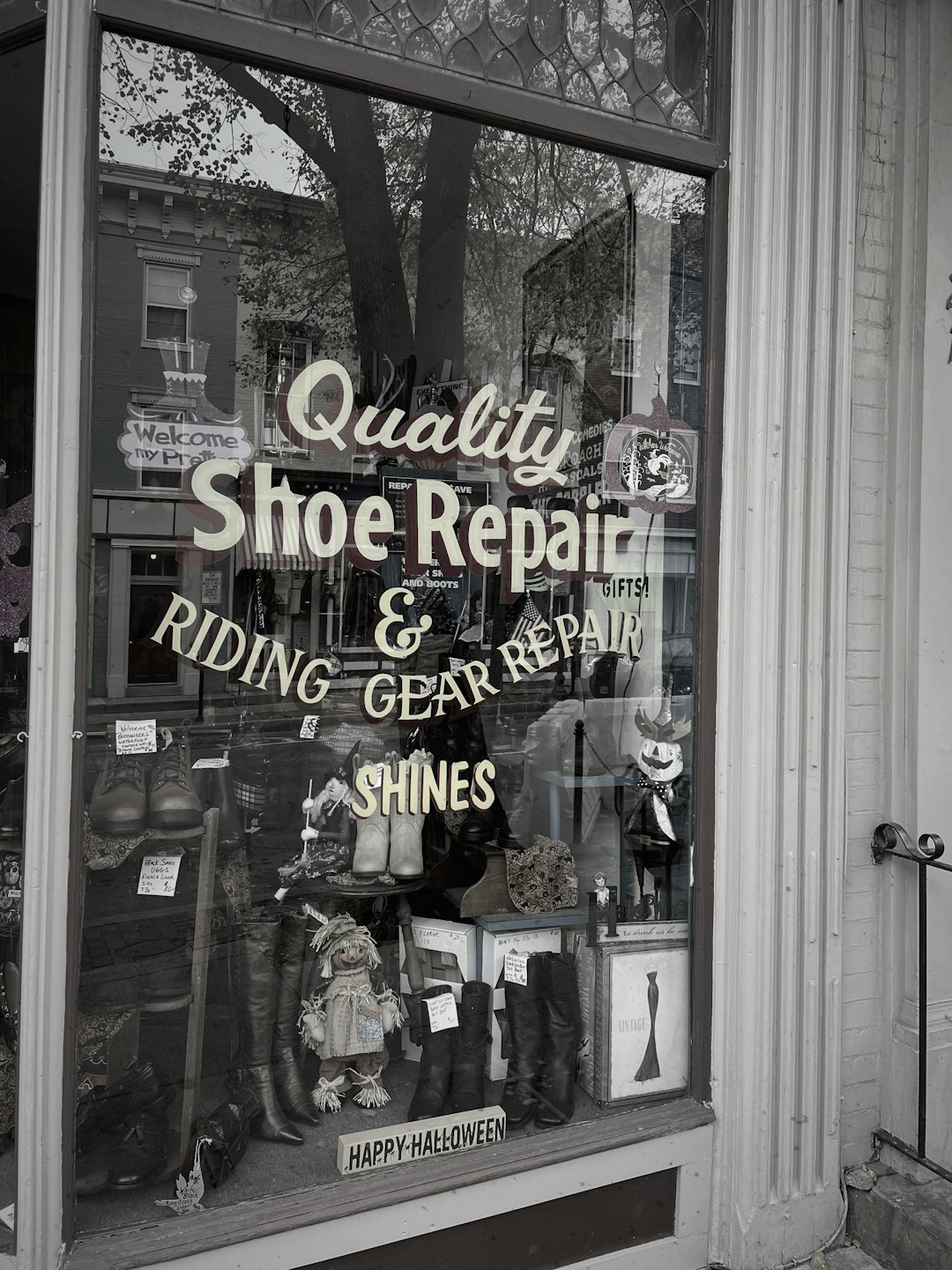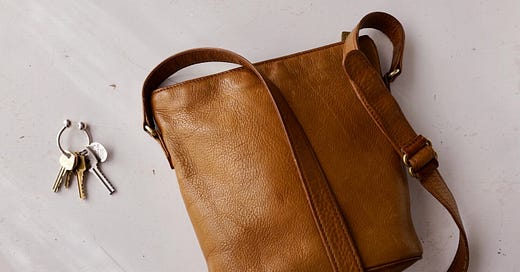I recently made a trip to midtown to collect two of my belongings that I had dropped off for repair. One was a leather bucket purse that I’d left with the cobbler for cleaning and conditioning. The other was a silver key chain that needed its end soldered back on. I’d deposited these items back in December, but getting to midtown again ended up taking me two months. I’m also ashamed to admit that my key chain had spent eight years sitting in a drawer waiting for me to get it fixed. Does this sound like a familiar scenario for some thing in your life?
As it turns out Tiffany, the maker of my key chain, has a whole department devoted to repair, so getting my key chain fixed was a breeze. Based on my observations: Their repair business is booming. On the afternoon that I picked up my key chain, there was more customer action in the repairs section of the store than just about anywhere else. I suspect there’s more behind this fervor for repair than the cachet of the little blue box those items originally came in. Tiffany is the type of store that people shop when they are buying a significant gift, something to mark a milestone, so their merchandise is often sentimental. In my case, the keychain was a gift from my husband on the eve of our married life—tender to the max.
The key ring looks as good as new after the professional polishers had their way with it (so much so that they all but buffed my initials off the fob), but there’s an element of stubborn sustainability in maintaining the handbag I also retrieved. The purse admittedly looks worn at this point in its life, no amount of conditioning from the shoe shine team will make it look new again. Yet I still love it, and I want to keep it looking its best for as long as possible.
I tell you about these things in part to encourage you to repair the things you love–and not to let them linger in drawers unused. But I also wanted to write about maintaining these beloved things because it got me thinking:
What had compelled me to invest in repairing these particular belongings–and why don’t I do it with everything I own?

One could argue that the money I spent on the keychain repair was a waste, that the simple ring from the hardware store that held my keys for eight years was completely sufficient for the task–and you would not be wrong.
But the key ring was exactly the kind of gift that I love to receive: The one that you would never buy yourself because it is a little frivolous. I enjoy how solid it feels in my hand. I feel just a whisper of joy every time I fish my keys out of my purse. Now that its back in rotation after all those years, it reminds me of that exciting time when my husband and I were newly-wed and I felt so grown up: Married and carrying a Tiffany key ring! The purse is imbued with nostalgia as well: My mom bought me that bucket bag to take on a mother-daughter trip the summer when I was twelve. Carrying it today, I remember how sophisticated I felt to have a leather purse. Then and now, I love that I can carry it and have my hands free for something else. I’ll admit I get a real kick out of telling anyone who admires it that I got it as a tween.
I also get a nostalgic thrill every time I slip on my cowboy boots bought on Bleeker Street one night with my best friend (they’re clocking their 20th year and countless repairs). My decade-old Barbour jacket is looking worse for wear, but it’s like an old friend at this point, so I’ll take it in to have its holes patched and spend a few hours oiling its parched canvas. I’ll willingly devote time and money into the care of things that are more than just, well, things.
What if every object we owned was this well-loved?
Okay, everything might be a big ask, but what if the big purchases were made with a little more thought and care? I know more people would be motivated to maintain loved things. We’d throw out less. We’d also buy a whole lot less in the first place.
By way of example: I’ve been hemming and hawing about buying a summer-weight quilt for our new larger bed. My husband and I independently admired quilts made by an artisan in Rhode Island–handmade things of beauty that are unfortunately beyond our budget. But buying one would be the kind of purchase that would inspire caretaking. Our old quilt, which hailed from a run-of-the-mill catalog company, had hung on since my teenage years. I even patched it when holes appeared, but when the edges had finally all frayed, I dropped it off at the textile recycling–no guilt. The four-figure quilt would be a different story though wouldn’t it? That’s the sort of thing I would have taken to the tailor as asked Can you give it a new binding? with no hesitation about spending on the restoration.
If there were some milestone on our horizon or just in our rearview mirror to mark (a marriage, a baby, a new home), maybe I’d have the guts to take the plunge on that handmade quilt, but more likely, I’ll just end up buying something unremarkable. Budgets existing in reality and all. But perhaps I’ll stretch just a little to get the slightly nicer coverlet that I admired in a hotel five years ago–and maybe that will be enough to turn me into its steward, not just its temporary owner.
Reflecting on the things I’ve lovingly maintained, I’ve made a few guidelines for how to shop for things you’ll actually want to repair and use long after their initial shine has faded:
Stretch your budget to the outer limits to buy the highest quality you can possibly afford. Wait, and save a little more before shopping. Strive to buy the best.
Stick to materials you know age well: high-quality metals, stone, leather, wool, canvas, and other natural fibers. Avoid anything plastic-y or with polyester woven in for “performance.”
Ask the manufacturer: Does your company offer repairs? If they don’t, think twice.
Seek out timeless designs. This one’s a tricky directive because styles change and it’s hard to predict what will last, but I do this by looking backwards, rather than forwards. Would my grandmother have admired the item? What about my great grandmother?
Try to tie big purchases to a moment, so the objects are imbued with meaning. Keep the shabby handbag going a little longer, so you can wait to buy a new purse on the occasion of a promotion or a new job. Content yourself with the meh sheets for another year to splurge on the special ones for your ten-year anniversary. Go ahead and force a connection on a purchase. I need a new pair of black pants–perhaps I will tell myself they are the first thing I ever bought with earnings from Substack?
Further reading:
If you’re interested in repair, I recommend the book Repair Revolution: How Fixers Are Transforming Our Throwaway Culture by John Wackman and Elizabeth Knight. It’s full of interesting reflections from the co-founders of a repair café. Try this one as a physical book (not an e-Book). I found it’s the sort you’ll want to dip in and out of and refer back to earlier bits.
If you’re hungry for more meditations on materialism and whether or not we have control over what we bring into our homes, read ‘The Great Wooden Toy Debate’ from Sara Petersen’s newsletter. This little nugget blew my mind: The U.S. has 3.1% of the world’s children, but consumes 40% of the world’s toys.
writing.
Last year I wrote a piece for Scary Mommy about why I bother to patch my kid's hole-ridden clothes. Different motivations for repair here, but the same bigger idea that it’s worth keeping our possessions in circulation longer.
reading.
I recently came across writer Jo Rogers’ The Run of the Downs series for House & Garden about moving to the country for a year. She’s back in London and the column wrapped up more than a year ago, but I just gobbled up Jo’s writing and wished there was more first-person writing about home like this. Don’t you? (Also: I am a sucker for pretty much any English country house content.)
subscribing.
I almost didn’t open this edition of Susan Spungen’s newsletter because I make a variation on tofu curry every couple weeks, but I am so glad I did. It’s an example of what makes Susan’s newsletter great: She shares little tips that she’s gleaned over decades of cooking, like what kind of tofu she prefers for this type of stew (different from the one I usually grab!) and how she tweaks “lite” coconut milk for the broth (I’m intrigued), that I find invaluable.
💌 If you have feedback or ideas for what I should write about, please email me or comment below.







Finding high quality clothing, transparent brands, ethical production.. was a challenge. Having less, but better, is the way to go!
Tiffany remains one of the last civilized places in our realm. I, too, have that keychain (and loved registering my address in case it got lost and someone was kind enough to return it). What I did lose was the end knob. It rolled off somewhere in my old duplex, never to be found again (even when moving). Loved going to Tiff to get a replacement. I can't recall if it was free or a whopping $10, but I so appreciated their kindness and efficiency. I don't use that ring right now. It doesn't pair well with modern car key/fobs. For that, I love my Madewell key fob with a leather loop and brass clasp. They used to offer monograms for it, and those made the best gifts (under $20). Still a great gift, but the monogram made it special. And love the bucket purse, Laura! Well-loved classics never go out of style, and that patina makes it one-of-a-kind. xo